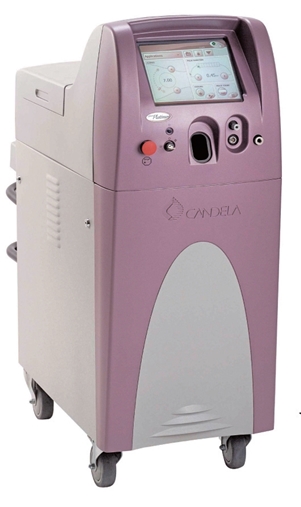▶ Previous Artlcle : #1-1. Pulsed Dye Laser Treatment
Selecting the spot size
One laser device has many handpieces and tips which can be easily replaced to change the spot size. Selecting the spot size suitable for the vessel diameter and size of the lesion is crucial to minimizing side effects and optimizing efficacy. In general, the spot size is set slightly larger than the diameter of the target vessel. Also, a larger spot size is used for deeper lesions. For example, V-beam has better penetration with 10mm than 7mm.
[Advertisement] FCR® (Fractional Prickle CoralCalcium Regentron) – Manufacturer: (www.thermoceutical.asia)]
Pulsed dye laser
Flash lamp pulsed dye laser with wavelength of 585~600nm is the most commonly used laser for vascular treatment. The most well-known devices are Candela’s V-beam series of 595nm and Cynosure’s V-Star of 585nm (Recently, Synergy, a version combining two wavelengths of 585nm and 1064nm is also available). These lasers are ideal for treating vascular lesions of the superficial skin and medium depth vessels. Since I use V-beam in my practice, I would like to share my clinical experiences with this device.
V-beam has deeper penetration compared to KTP laser of 532nm. It is particularly efficacious in vascular lesions on the superficial skin such as port-wine stains, hemangioma, telangiectasis, rosacea, erythematous scar, and poikiloderma, etc. Although V-beam devices have differing parameters and handpieces suitable for different diseases, in my experience it is not as efficacious as other diseases in treatment of varicose veins of lower limb. Disadvantages of this device would be the high purchase price and maintenance cost. The lasing medium of dye needs replacement and the cooling system of cryo-spray (DCD) is also quite costly.
Treatment can be customized using various spot size tips and pulse duration of 0.45~40 msec. Generally, 7mm, 10mm tips are frequently used for treatment and shows faster treatment rate when treating wide lesions than when treated with the dual yellow or 1064nm Long Pulsed Nd:YAG.
The treatment is painful to the extent that adults can endure but local anesthesia is required for pediatric patients. Common local anesthetic ointments for laser procedures are not advised as they have vasoconstrictive effect and unsatisfactory level of pain reduction. However, intravenous sedative anesthesia or general anesthesia is not always applicable. I personally do not use anesthesia in general but when deemed necessary, I explain the possibility of lowered efficacy to the patient or caregiver before using local anesthesia. In my experience, the treatment effect slightly decreased in port-wine stains but the difference was not clinically significant.
Purpura is a common mild complication of the treatment. A short pulse duration of 3 msec or less creates conspicuous purpura. Purpura is a type of bruising caused by damaged capillaries on the superficial skin. When purpura occurs in the target vessels, it leads to the wanted therapeutic effect. However, it can interfere with follow-up procedures when the targeted lesional vessels are actually deeper and thicker vessels than the destroyed superficial vessels.
For these reasons, longer durations should be tried first when using multiple passes with various pulse durations. However, a single pass with a single pulse duration is generally used per procedure. There are some reports on the benefit of multiple passes with energy low enough to avoid purpura, however, it has not been approved yet.
In biopsy, port-wine stains present vasodilation of varying degrees and depth within the same dermal lesion. This makes the prediction of treatment outcome difficult. In fact, certain lesions respond well to treatment whereas the other lesions of the same patient persist.
Although the preferred pulse duration ranges from 0.45 to 3 msec in general, it requires multiple procedures of varying pulse durations to bring therapeutic effect. Therefore, treatment is complicated and sometimes requires over 20 procedures, which may result in poor compliance. I set the basic parameters as 1.5 msec, 10mm spot size, 5~8J and start treatment with low output and carefully observe vascular response or clinical effect to subsequently adjust pulse duration or other parameters in the follow-up procedures.
The redness is drastically reduced after several procedures. The best outcome is seen in the face whereas it is poor in the legs. The usual treatment interval is set to 4-6 weeks. According to the latest literature, treatment in the earlier interval is likely to bring better outcome due to additional vascular damage. If tolerable, the treatment period should not exceed 3-4 weeks.
In my clinical experience, I have encountered cases with persistent pigmentation due to excessive laser energy (most common in lower limb lesions of a darker-skinned patient). In such cases, the treatment is suspended for about 3 months until the pigmentation improves. On the other hand, patients with darker skin may experience hypopigmentation, however, all patients recovered to pigmentation in my practice.
Purpura is quite common in treatment of port-wine stains as the affected vessels are small. To examine whether the wanted vascular injury is given or not, I shoot the laser on the border between the lesion and normal skin to examine purpura. When purpura formation is more prominent in the lesional area, I determine that the laser treatment is selectively effective on the target vessels.

V-beam, most widely used PDL
References
❶ Boon LM, Vikkula M. Vascular malformations. In: Fitzpatrick’s Dermatology in General Medicine, 8th ed. New York: McGraw Hill, 2012:2076-2094.
❷ Chen JK, Ghasri P, Aguilar G, van Drooge AM, et al. An overview of clinical and experimental treatment modalities for port wine stains. J Am Acad Dermatol. 2012 Aug; 67(2):289-304.
❸ Grunewald S, Bodendorf MO, Paasch U (Reviewed by Young-geol Kim, Min-ji Kim). Clinical application of vascular laser. Hansol Medicine, 2012.
❹ Lui A, Moy RL, Ross EV, et al. Pulsed dye laser and pulsed dye laser-mediated photodynamic therapy in the treatment of dermatologic disorders. Derm Surg. 2012;38:351-366
-To be continued-
▶ Next Artlcle : #2-1. Port-wine Stain





















